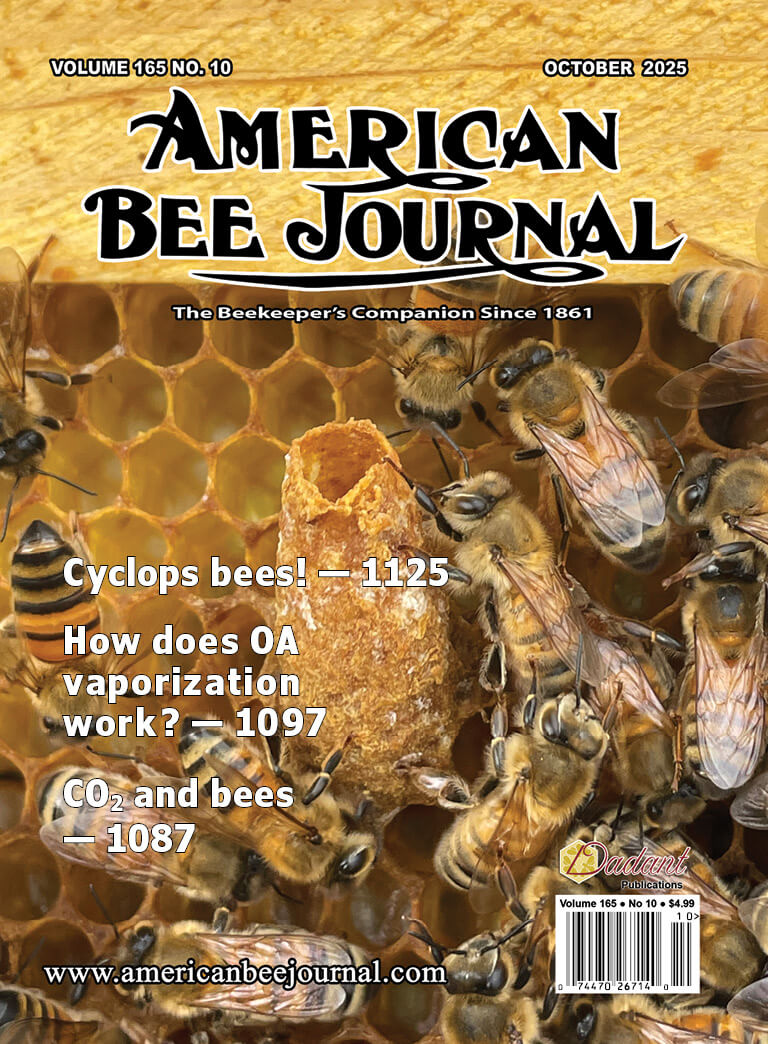A Dream Team?
Milbrath, Webster, Oliver and Ellis all in the same edition?
AWESOME!
That’s a whole lot of practical beekeeping with the science to back it.
John G. Yakim RPh
Pittsburgh, PA
Playing Opossum
Reference: Queens “Playing Possum” (December 2019 letters):
First of all it’s spelled with a “silent” O! You can take the teacher out of the classroom, but you can’t take the classroom out of the teacher.
Two of my idols in beekeeping are: Randy Oliver and Sue Cobey, the developer of the New World Carniolan. Many years ago while attending the Los Angeles County beekeepers club annual picnic I had a chance to demonstrate queen marking. No fancy marking tube devices had been invented at the time. So I brought an unmarked queen and began to mark her. No marking pens existed at that time in the 1970s. If they did we did not use them. What was available at that time was a small bottle the size of nail polish, from Los Angeles Honey Co., with a stem in the lid missing a brush. Worked great.
So when it came time to show off my prowess marking queens I did so only to have the queen “faint.” In my not so humble opinion queen fainting is a more appropriate description of what sometimes happens when you handle a queen. It happens now and then to this day, even in the marking tube!
I panicked and thought I’d killed her. Expressing my dismay a senior beekeeper put his hand on my shoulder and exclaimed: “She just fainted, son. Give her a few minutes and she will recover,” which she did and I got her back into a wooden Benton queen cage. JZ BZ cages had not been invented until decades later.
Just a note on banking a queen using a JZ BZ plastic cage. A couple years back I needed to ‘bank’ one of my special breeder queens in a nuc. A disaster ensued as the queen crawled up into the candy tube and died! Sitting down in the bee yard and crying didn’t help much, but I did feel a little better after this.
W. Montgomery
Southside, AL
Master Beekeeper Young Harris
Beekeeping Institute, UGA
Are Northern Queens Really Better?
Dear Editor
I was puzzled by the statement by Kirk Webster: “It seems hard to imagine now, but before 1985, most queens used by American beekeepers were raised in a few southern states and California.” Glancing at the advertising in the Bee Journal, it appears that the bulk of bees sold still come from these sources. Although I have heard numerous claims, I have seen no hard evidence that northern bred queens are superior than those produced in the South, California, or Hawaii. Quality depends chiefly on the methods of production and not the latitude where the bees are grown.
Peter Borst
Ithaca, NY
U S A
Keep up the good work
Good evening,
I just laid down my January issue of the ABJ and have been again impressed with the quality of this publication. I can’t get too much of the practical articles such as Kirk Webster’s and Grant F. C. Gillard’s in this issue. I always take a closer look when I see the names of successful beekeepers as authors, especially those who are putting forth effort to increase bee health through selection of genetics. Some of my most successful practices in my apiary have been crystalized from articles printed in the ABJ and I look forward to putting to use the many more practical ideas I find in each issue.
Also in regards to the magazine in general, I have seen only improvement in the layout, content, etc. with new editors bringing in fresh ideas. I feel that I get every dollar’s worth out of my subscription. Thanks for all you have done in the past year and please keep up the good work.
Sincerely,
Jeffrey Detweiler
Elkton, Maryland
We cannot value almond pollination in isolation
Hi Eugene,
Christmas day and the sun is shining and the bees are working and the forecast max temperature is 38 C (about 100 F).
I received the December ABJ yesterday and read your editorial, followed by a quick glance through The Classroom’s questions and settled to read Scott McArt’s article about the economics of almond pollination.
Quick background: I escaped from Grammar school in England in 1945 and started work in the office of a chartered accountant with the plan of qualifying. After 3 years of auditing and study I decided that the only part of the job I enjoyed was Cost Accountancy, and the thought of spending the rest of my life studying company accounts and looking after other people’s money had lost its appeal. And the studying was interfering with my rock climbing and other important pursuits. So I changed tracks.
I migrated to Australia in 1950, did a variety of jobs including dozer driving and, in December 1952 became a commercial beekeeper and the bit of accountancy that I had learnt helped me a lot. Especially the understanding of costing.
And so I find, from reading the ABJ since 1976, that an American beekeeper’s work at the end of winter, involves a lot of expense in dealing with dead outs, feeding to build populations, treating for mites and so on. And those costs are incurred whether or not he/she pollinates almonds.
Some years ago, I read about a beekeeper in one of the cold states, maybe Montana, that he took his bees to the …


